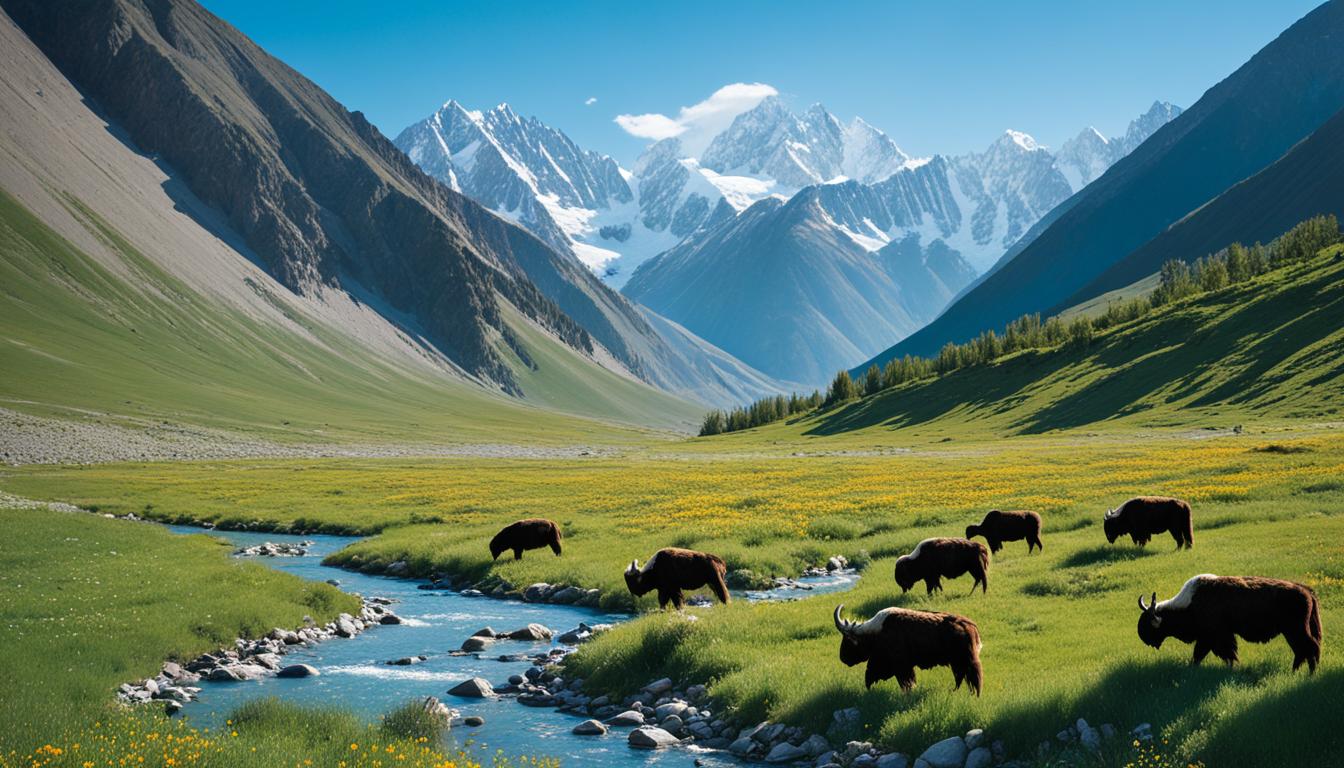Costa Rica Sacred Natural Sites and Biodiversity
Did you know that Costa Rica is home to a staggering 6% of the world’s biodiversity, despite covering just 0.03% of the Earth’s surface? This small Central American country is a nature lover’s paradise, with an abundance of sacred natural sites and wildlife that captivate the hearts of eco-conscious travelers. Costa Rica’s commitment to nature conservation, eco-tourism, wildlife preservation, and environmental protection has made it a global leader in sustainable tourism.
Key Takeaways:
- Costa Rica boasts 6% of the world’s biodiversity, despite its small size.
- The country is renowned for its sacred natural sites and diverse wildlife.
- Costa Rica is committed to sustainable tourism and environmental protection.
- Eco-conscious travelers flock to Costa Rica for unforgettable nature experiences.
- Costa Rica sets an example for other countries in biodiversity conservation and eco-tourism.
Reserva Huaravito: Costa Rica’s Haven for Eco-Tourism
Nestled within the Montes del Aguacate Biological Corridor, Reserva Huaravito is a private protected area that offers a breathtaking tapestry of nature’s wonders. It provides opportunities for eco-tourists to immerse themselves in lush cloud forests, encounter exotic flora and fauna, and indulge in authentic Costa Rican cuisine. Reserva Huaravito is more than just a destination; it is a commitment to sustainable tourism and conservation, providing enriching experiences that connect visitors with the soul of Costa Rica.
If you’re looking for an eco-tourism haven that combines natural beauty, sustainability, and mouthwatering cuisine, look no further than Reserva Huaravito. This hidden gem is located in the Montes del Aguacate Biological Corridor, a region known for its pristine ecosystems and diverse wildlife. As you step into the reserve, you’ll be greeted by lush cloud forests teeming with unique flora and fauna.
Reserva Huaravito offers a range of activities that allow you to fully immerse yourself in the wonders of nature. Whether you’re trekking through the forest trails, birdwatching from elevated viewpoints, or embarking on a guided nature walk, every experience will leave you in awe of Costa Rica’s natural beauty.
But Reserva Huaravito isn’t just about nature; it’s also about indulging in the delightful Costa Rican cuisine. The reserve partners with local farmers and culinary experts to offer authentic and sustainable dining experiences. From farm-to-table meals made with fresh, locally sourced ingredients to traditional Costa Rican dishes bursting with flavor, every bite is a journey through the country’s vibrant culinary scene.
“Reserva Huaravito is a true eco-tourism haven, where visitors can connect with nature, savor the tastes of Costa Rican cuisine, and contribute to sustainable tourism,” says Maria Rodriguez, a seasoned eco-traveler who recently visited the reserve.
Reserva Huaravito goes beyond providing remarkable experiences for visitors. It is committed to sustainable tourism and conservation, ensuring that future generations can continue to enjoy and appreciate the natural wonders of Costa Rica. The reserve actively engages in reforestation efforts, wildlife protection initiatives, and community development projects, all aimed at preserving the delicate balance of the ecosystem.
So, if you’re seeking an eco-tourism haven that offers an immersive connection with nature, enriching cultural experiences, and sustainable practices, make Reserva Huaravito your next destination. Prepare to be captivated by the beauty of Costa Rica while leaving a positive impact on its natural heritage.
| Reserva Huaravito Highlights: |
|---|
| Immerse yourself in lush cloud forests |
| Encounter exotic flora and fauna |
| Indulge in authentic Costa Rican cuisine |
| Experience sustainable tourism |
| Support conservation efforts |
The Importance of Biodiversity in Costa Rica
Costa Rica understands the significance of biodiversity in its natural ecosystems, realizing the multiple benefits it provides. Biodiversity not only supports the conservation of various species but also plays a crucial role in watershed protection, carbon fixation, genetic material utilization, maintenance of scenic beauty, and the production of water and energy.
Conservation efforts in Costa Rica prioritize the sustainable use of its biological resources and the preservation of natural habitats. By safeguarding forests and other ecosystems, Costa Rica not only protects its diverse flora and fauna but also ensures the long-term sustainability of essential ecological functions, such as water purification and energy production.
Biodiversity serves as the foundation for Costa Rica’s environmental policies and initiatives, forming the backbone of its commitment to conservation and sustainable development. The country recognizes that a healthy and diverse natural environment is not only critical for the well-being of its inhabitants but also for the future generations to come.
In order to effectively address the challenges associated with biodiversity loss and habitat degradation, Costa Rica places great emphasis on scientific research, community engagement, and policy implementation. These comprehensive strategies aim to preserve and restore ecosystems, protect endangered species, and promote the sustainable management of natural resources.
“Biodiversity is not just a luxury but a necessity for the well-being and future development of Costa Rica.”
Costa Rica’s commitment to biodiversity conservation extends beyond its borders. The country actively participates in global efforts to protect ecosystems and promote sustainable practices, often serving as a role model for other nations facing similar challenges.
Furthermore, Costa Rica recognizes the interconnectedness of biodiversity conservation with sustainable tourism. The country’s stunning natural landscapes and abundant wildlife attract tourists from around the world, contributing to the economy while raising awareness about the importance of biodiversity conservation.
Costa Rica’s dedication to preserving its unique biodiversity serves as an inspiration for other countries and reinforces the understanding that the well-being of our planet relies on the responsible stewardship of nature. Through its continued efforts, Costa Rica leads the way towards a more sustainable and harmonious future for both humans and the diverse species that call this remarkable country home.
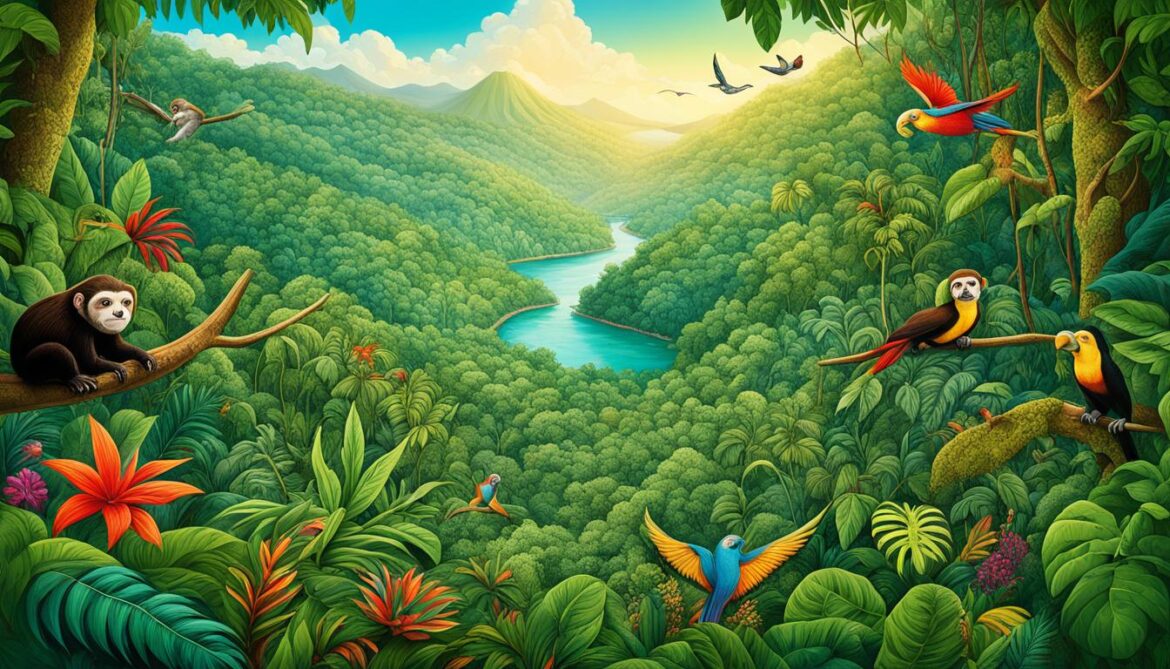
Key Points:
- Costa Rica recognizes the value of biodiversity for ecosystem services like watershed protection, carbon fixation, and energy production.
- The conservation and sustainable use of natural resources are a priority in Costa Rica.
- Costa Rica’s commitment to biodiversity conservation extends beyond its borders.
- The country’s dedication to preserving biodiversity serves as a role model for other nations.
- The interconnectedness of biodiversity conservation and sustainable tourism is emphasized in Costa Rica.
The Role of Infrastructure in Promoting Costa Rica’s Biodiversity
A study conducted in Costa Rica reveals that biodiversity alone does not solely drive tourism. Infrastructure, including hotels and roads that provide access to nature, plays a crucial role in attracting tourists. Costa Rica’s model of tourism infrastructure focuses on the development of small ecolodges and nature hostels, promoting sustainability while benefiting both the economy and the environment.
The combination of biodiversity and well-designed infrastructure has made destinations like Monteverde immensely popular among tourists. Monteverde’s reputation for being a haven of endemic and threatened species is enhanced by the presence of comfortable and sustainable accommodations.
The availability of hotels and roads that provide easy access to natural wonders is essential for creating memorable experiences for tourists. Costa Rica has recognized this need and invested in the development of transport networks and accommodations that are intimately connected with nature.
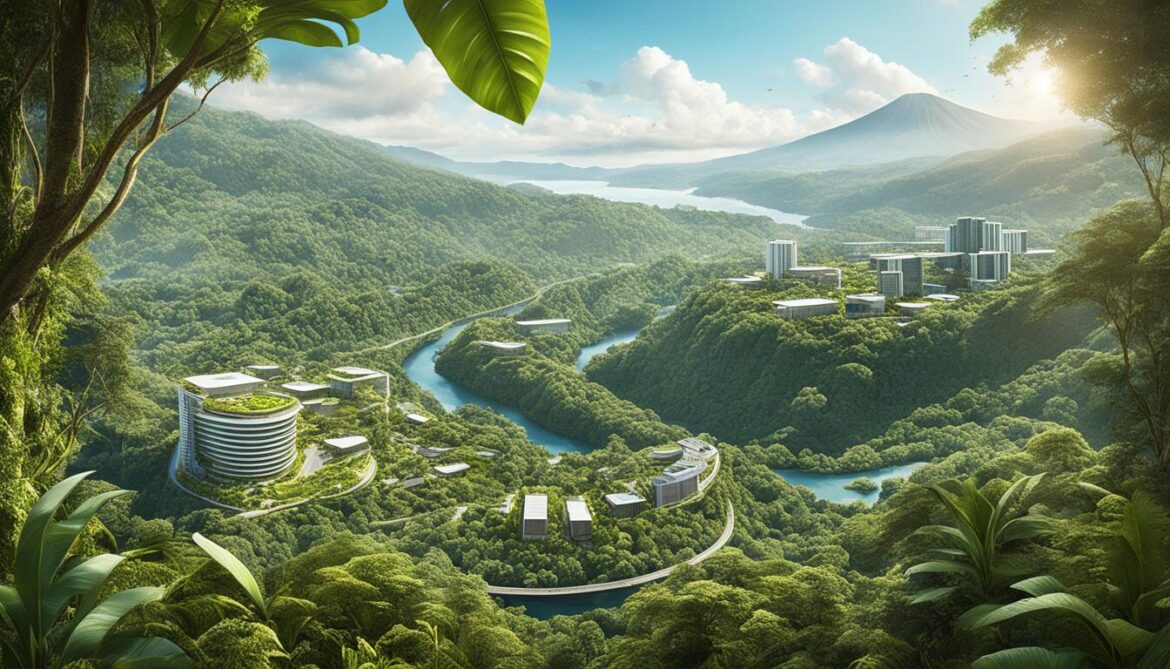
Costa Rica’s Sustainable Tourism Infrastructure
Costa Rica’s commitment to sustainable tourism has led to the development of an infrastructure that complements and preserves the country’s rich biodiversity. The focus on small-scale accommodations such as ecolodges and nature hostels ensures that tourism development is in harmony with the environment.
By staying at these carefully curated establishments, tourists can enjoy the beauty of Costa Rica’s natural landscapes while minimizing their impact on the environment. The small-scale and environmentally-conscious nature of these accommodations allows visitors to immerse themselves in the surroundings and connect with the country’s unique flora and fauna.
The well-maintained network of roads in Costa Rica ensures that tourists can explore the country’s stunning natural landscapes with ease. From the dense rainforests to coastal reserves, these well-connected roads make it convenient for visitors to reach their desired destinations.
The Economic and Environmental Benefits
The combination of a diverse infrastructure and an abundance of biodiversity brings significant benefits to Costa Rica. The presence of comfortable accommodations and well-connected roads attracts tourists from around the world, contributing to the country’s economy.
Furthermore, the development of sustainable tourism infrastructure helps protect Costa Rica’s delicate ecosystems. By providing tourists with the opportunity to experience nature in a responsible and sustainable manner, the country ensures the long-term preservation of its biodiversity.
| Benefits of Infrastructure in Promoting Biodiversity | Benefits of Infrastructure in Promoting Economy |
|---|---|
| ● Enhances accessibility to natural sites | ● Boosts tourism revenue |
| ● Encourages responsible tourism practices | ● Creates employment opportunities |
| ● Enables conservation efforts and research | ● Stimulates local businesses and industries |
The sustainable tourism infrastructure in Costa Rica not only provides tourists with unforgettable experiences but also supports the conservation and preservation of the country’s unique biodiversity. This approach sets a positive example for other destinations seeking to balance tourism development with the protection of natural resources.
Ecotourism and Conservation in Costa Rica
Costa Rica has emerged as a leading destination for ecotourism, attracting visitors from around the world who are passionate about experiencing and preserving the country’s natural wonders. With its rich biodiversity and commitment to sustainable tourism practices, Costa Rica has become a model for conservation efforts.
Ecotourism, at its core, is a form of tourism that promotes responsible travel, focusing on conserving the environment and improving the well-being of local communities. In Costa Rica, ecotourism provides economic incentives for conservation efforts, supporting the protection of the country’s diverse ecosystems and fragile wildlife habitats.
“Ecotourism is not just about passive observation; it is about inspiring visitors to actively engage in the preservation of nature and support local communities.” – José Rodríguez, Director of the Costa Rica Tourism Board
By participating in eco-friendly activities such as guided nature hikes, wildlife conservation projects, and community-based initiatives, visitors contribute directly to the conservation of Costa Rica’s unique ecosystems. This symbiotic relationship between ecotourism and conservation helps ensure the long-term sustainability of the country’s natural resources.
One of the notable benefits of ecotourism is its positive impact on local communities. By promoting community involvement in tourism activities, Costa Rica empowers local residents to actively participate in the conservation of their natural heritage. This collaboration not only supports the livelihoods of the local population but also fosters a sense of pride and ownership in protecting the environment for future generations.
Through ecotourism, Costa Rica raises awareness about the importance of preserving biodiversity and the need for sustainable tourism practices. Visitors gain a deeper understanding of the delicate balance between human activities and the natural world, fostering a sense of responsibility towards conservation.
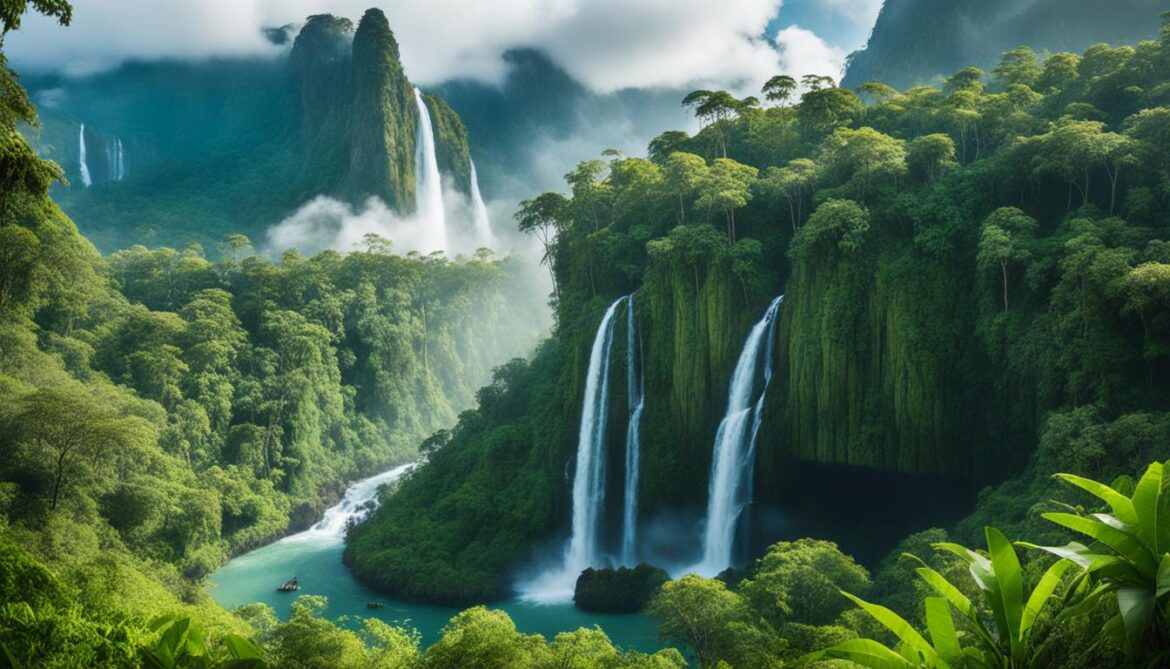
The Benefits of Ecotourism in Costa Rica
When discussing the benefits of ecotourism in Costa Rica, it is important to consider both environmental and socio-economic aspects:
| Environmental Benefits | Socio-Economic Benefits |
|---|---|
| Preservation of ecosystems and biodiversity | Creation of jobs and income for local communities |
| Conservation of threatened species | Promotion of cultural preservation |
| Protection of natural resources | Investment in community development |
These benefits highlight the transformative power of ecotourism, which goes beyond mere travel experiences. Ecotourism in Costa Rica is a catalyst for positive change, promoting a harmonious relationship between humans and nature.
By choosing to engage in responsible tourism practices and supporting local conservation efforts, visitors to Costa Rica become stewards of the environment, actively contributing to the preservation of the country’s unique biodiversity. Through ecotourism, Costa Rica demonstrates that sustainable tourism can be a force for good, ensuring the protection of natural habitats and cultural heritage for generations to come.
The Relationship Between Biodiversity and Tourism
A study conducted in Costa Rica explored the impact of biodiversity on tourism. Researchers aimed to determine if the opportunity to observe a wide variety of vertebrate animal species influenced tourists’ choices. The study found that simply having an abundance of animal species was not sufficient to drive tourism. Instead, it was the combination of biodiversity and well-developed infrastructure that enabled access to nature that attracted visitors. Destinations like Monteverde, renowned for their endemic and threatened species, have become popular tourist destinations due to the availability of ecolodges and the richness of their biodiversity.

Costa Rica’s remarkable biodiversity plays a pivotal role in attracting tourists. The country is home to a vast array of ecosystems, including rainforests, cloud forests, and coastal regions, each harboring unique wildlife. Tourists are captivated by the opportunity to witness the incredible species richness found in Costa Rica, from vibrant birds and breathtaking orchids to elusive jaguars and toucans. Coupled with easy access to these natural wonders through well-established infrastructure, Costa Rica presents an ideal destination for nature enthusiasts and eco-conscious travelers seeking immersive experiences.
Moreover, the positive relationship between biodiversity and tourism extends beyond cultural and economic aspects. By experiencing the awe-inspiring biodiversity that Costa Rica offers, tourists develop a deeper appreciation for the importance of conservation. They become potential advocates for environmental preservation, spreading awareness and supporting initiatives aimed at safeguarding the country’s natural heritage.
“Costa Rica’s rich biodiversity, combined with its commitment to sustainable tourism practices, offers visitors a transformative experience. By nurturing a harmonious relationship between biodiversity and tourism, Costa Rica sets an example for the world in preserving nature and promoting sustainable travel.”
In summary, the study conducted in Costa Rica confirms that a thriving biodiversity alone is not solely responsible for driving tourism. It is the synergy between diverse animal species and well-developed infrastructure that entices visitors. Costa Rica’s commitment to preserving its natural resources while ensuring easy access to protected areas has created a virtuous cycle, attracting tourists who appreciate the importance of biodiversity conservation. This harmonious relationship between biodiversity and tourism showcases Costa Rica’s role as a global leader in sustainable travel.
| Key Findings | Implications |
|---|---|
| Tourism driven by biodiversity and infrastructure | Investment in infrastructure is crucial for attracting tourists |
| Ecolodges and well-developed roads increase tourism | Support for sustainable lodging and transportation initiatives |
| Monteverde’s biodiversity and ecolodges draw tourists | Promotion of other biodiverse destinations with similar infrastructure |
Indigenous Communities and Conservation in Costa Rica
Indigenous communities in Costa Rica play a vital role in the country’s conservation efforts. Their traditional knowledge and sustainable practices contribute significantly to the preservation of biodiversity and the protection of sacred natural sites. These communities have a deep connection to the land and possess invaluable wisdom passed down through generations.
Through community-based environmental education programs and active participation in ecotourism initiatives, indigenous communities actively promote livelihoods, community empowerment, and the conservation of vulnerable species, such as sea turtles.
“Having lived in harmony with nature for centuries, indigenous communities possess a unique understanding of the delicate balance between humans and the environment. Their commitment to sustainable practices inspires us all to protect and preserve the rich biodiversity that Costa Rica is known for.” – María Fernández, Environmental Educator
Cultural Heritage and Natural Conservation
Indigenous communities in Costa Rica have a profound respect for nature and view themselves as stewards of their ancestral lands. They believe that the well-being of their communities is intertwined with the health of the ecosystems they inhabit. By preserving biodiversity and protecting sacred natural sites, indigenous communities ensure the continuity of their cultural heritage and maintain their spiritual connection to the land.
Furthermore, these communities actively engage in sustainable agricultural practices, using traditional farming methods that prioritize harmony with nature and the preservation of biodiversity. Their deep knowledge and understanding of the natural world have enabled them to develop sustainable systems that have minimal impact on the environment.
Community Empowerment and Economic Sustainability
Through the development of community-based ecotourism initiatives, indigenous communities not only conserve their natural resources but also empower themselves economically. By offering unique experiences that showcase their traditions, cultural practices, and rich biodiversity, they create sustainable livelihoods for community members.
Ecotourism activities, such as guided tours through pristine forests, handicraft workshops, and cultural exchanges, provide direct economic benefits to indigenous communities. These initiatives allow visitors to learn from the expansive knowledge of these communities while supporting their efforts in conservation and community development.
The Importance of Collaboration
Collaboration between indigenous communities and governmental and non-governmental organizations is key to the success of conservation efforts in Costa Rica. By working together, these stakeholders can pool their resources, knowledge, and expertise to develop effective strategies for protecting biodiversity and ensuring the long-term sustainability of both natural ecosystems and indigenous cultures.
The empowerment of indigenous communities is not only essential for biodiversity conservation but also for creating a more equitable society, where the voices and rights of these communities are respected and valued. Through cultural preservation and community-led conservation initiatives, Costa Rica demonstrates its commitment to empowering indigenous communities and promoting coexistence between humans and nature.
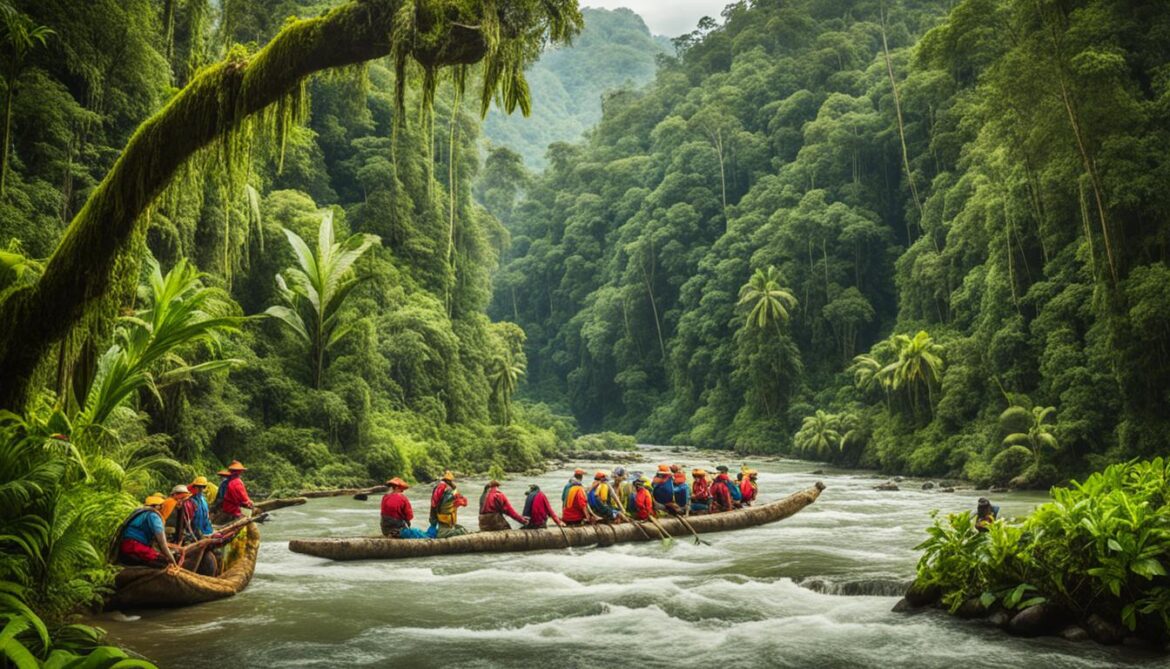
| Key Contributions of Indigenous Communities to Conservation in Costa Rica | |
|---|---|
| Preservation of biodiversity through sustainable practices | ✔ |
| Protection of sacred natural sites | ✔ |
| Community-based environmental education | ✔ |
| Participation in ecotourism initiatives | ✔ |
| Empowerment of indigenous communities | ✔ |
Field Course in Costa Rica: Exploring Biodiversity and Conservation
A field course in Costa Rica provides a unique and immersive opportunity for students to delve into the intricate world of tropical ecosystems and explore the critical issues surrounding biodiversity and conservation. This hands-on learning experience allows students to investigate the various biotic, physical, and cultural factors that shape and influence tropical biodiversity, gaining a comprehensive understanding of the challenges and solutions in conserving these fragile ecosystems.
During the course, students will have the chance to delve into the fascinating realm of sea turtle conservation, which plays a vital role in maintaining the delicate balance of coastal ecosystems. They will learn about the various threats faced by sea turtles and explore strategies for their protection and preservation.
The field course also delves into the realm of ecotourism, highlighting its significance as a sustainable approach to both environmental protection and community development. Students will examine how responsible tourism practices can contribute to biodiversity conservation, benefiting local communities and promoting long-term sustainability.
Another important aspect of the course is the exploration of the role of indigenous communities in biodiversity conservation. Students will engage with local communities to understand their traditional knowledge and sustainable practices that have contributed to the preservation of natural resources and the protection of sacred natural sites.
Furthermore, the field course emphasizes inquiry-based learning, allowing students to develop their research skills and tackle complex questions related to tropical biodiversity and conservation. Through fieldwork, data collection, and analysis, they will gain invaluable insights into the current state of tropical ecosystems and the impacts of human activities on species loss and conservation.
Course Highlights:
- Experiential learning in diverse tropical ecosystems
- Investigation of sea turtle conservation efforts
- Exploration of sustainable ecotourism practices
- Engagement with indigenous communities and their conservation efforts
- Inquiry-based learning and research on tropical biodiversity
By participating in this field course, students will acquire the necessary knowledge and skills to become advocates for biodiversity conservation and make a positive impact on the preservation of tropical ecosystems. They will develop a deep appreciation for the intricate interplay between human activities, biodiversity, and the urgent need for conservation strategies.

Course Locations in Costa Rica: Talamanca and Monteverde
The field course in Costa Rica offers students the opportunity to explore two diverse locations: Talamanca and Monteverde. These locations provide invaluable insights into biodiversity conservation and sustainable practices.
Talamanca: A Cultural and Ecological Haven
Talamanca is a culturally diverse region in Costa Rica, known for its rich biodiversity and protected areas. It is home to numerous national parks, indigenous territories, and the largest indigenous communities in the country. These indigenous communities play a crucial role in biodiversity conservation, leveraging their traditional knowledge and sustainable practices to protect the natural treasures of Talamanca.
Students will have the chance to immerse themselves in the unique blend of cultures and habitats found in Talamanca. From the lush cloud forests to the pristine rivers, students will gain firsthand knowledge about the delicate balance of nature and the interactions between indigenous communities and the environment.
Monteverde: Exploring the Enchanting Cloud Forests
Monteverde is renowned for its captivating cloud forests and its prominence as a leading research community. Students will have the opportunity to delve into the wonders of Monteverde’s cloud forests, a unique ecosystem where the misty air nurtures a vast array of flora and fauna.
Through educational programs and research projects, students will have a deeper understanding of the importance of cloud forests in sustaining biodiversity. They will explore the intricate relationship between plants, animals, and the cloud forest ecosystem, gaining insights into conservation strategies that help preserve this fragile and enchanting environment.
Visiting Talamanca and Monteverde allows students to witness the ecological and cultural aspects of biodiversity conservation. It provides an immersive experience that connects theory to real-world application, fostering a deeper appreciation for the delicate balance of nature and the importance of sustainable practices in preserving Costa Rica’s natural treasures.
Costs and Credits for the Field Course in Costa Rica
The field course in Costa Rica offers graduate students the opportunity to earn credits while exploring the country’s rich biodiversity and conservation efforts. This immersive experience allows students to gain practical knowledge and hands-on skills in the field of ecology and conservation.
Course Overview
The field course covers a range of topics related to biodiversity and conservation in Costa Rica. Students will delve into the unique ecosystems and species that make this country a hotbed of biodiversity. They will also learn about the conservation efforts undertaken by local communities and organizations to protect and preserve the natural resources of Costa Rica.
In-person Travel
The course requires students to engage in in-person travel to fully experience the diverse ecosystems and conservation projects in Costa Rica. This travel component allows students to witness first-hand the beauty of the tropical rainforests, cloud forests, and coastal habitats, as well as participate in fieldwork and research activities.
Course Costs
Participating in the field course involves certain costs, including tuition fees, accommodations, meals, transportation, and other basic expenses. The exact costs may vary depending on the duration of the course and the specific accommodations and amenities provided. However, the course organizers strive to keep the costs reasonable and provide students with an affordable yet enriching experience.
Funding Opportunities
Students who are concerned about the course costs can explore various funding opportunities. Scholarships, grants, and funding programs may be available to help offset the expenses associated with the field course. It is advisable for students to research and apply for these funding opportunities in advance to secure financial support.
Graduate Credits
The credits earned in the field course can be applied towards the students’ graduate program. Many universities recognize the value of hands-on field experiences and offer credits for participating in field courses abroad. These credits can contribute towards the completion of a graduate degree or be counted as elective courses.
Global Field Program (GFP)
The field course in Costa Rica is part of the Global Field Program (GFP), a comprehensive graduate program that focuses on field-based learning and global conservation initiatives. Completing the field course in Costa Rica can be a stepping stone towards pursuing the GFP or other approved programs, providing students with a broader understanding of international conservation efforts.

Conclusion
Costa Rica, with its sacred natural sites and abundant biodiversity, is a prime destination for eco-conscious travelers and nature enthusiasts. The country’s dedication to sustainable tourism practices and conservation efforts has not only brought economic benefits but also preserved the delicate balance of nature. Through pioneering initiatives such as ecotourism, community-based conservation, and active involvement of indigenous communities, Costa Rica has exemplified how biodiversity conservation and sustainable tourism can harmoniously coexist. By investing in infrastructure and protecting vulnerable species, Costa Rica sets a remarkable example for other nations to follow in promoting biodiversity conservation and sustainable tourism.








